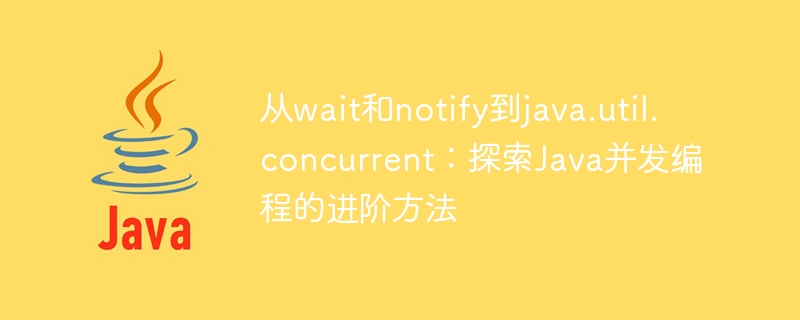Home >Java >javaTutorial >A deep dive into Java concurrent programming: from wait and notify to java.util.concurrent
A deep dive into Java concurrent programming: from wait and notify to java.util.concurrent
- WBOYWBOYWBOYWBOYWBOYWBOYWBOYWBOYWBOYWBOYWBOYWBOYWBOriginal
- 2023-12-20 15:45:581070browse

From wait and notify to java.util.concurrent: Exploring advanced methods of Java concurrent programming
In Java programming, implementing concurrency is a common but also quite difficult task. Challenging tasks. In order to effectively solve concurrency problems, Java provides some basic tools and classes, such as the synchronized keyword, wait and notify methods, and the Thread class. However, as applications grow in complexity, these basic tools often fall short. In order to better handle concurrency, Java also introduced the java.util.concurrent package, which provides some more advanced concurrent programming methods and tools. This article will explore some advanced methods from wait and notify to java.util.concurrent, while providing specific code examples.
wait and notify are methods in the Object class and are used to implement communication between threads. The wait method puts the thread into a waiting state until other threads call the notify method to wake it up. This mechanism is widely used to achieve synchronization between threads. The following is a simple example:
public class WaitNotifyExample {
public static void main(String[] args) {
final Object lock = new Object();
Thread thread1 = new Thread(() -> {
synchronized (lock) {
try {
System.out.println("Thread 1 is waiting");
lock.wait();
System.out.println("Thread 1 is resumed");
} catch (InterruptedException e) {
e.printStackTrace();
}
}
});
Thread thread2 = new Thread(() -> {
synchronized (lock) {
System.out.println("Thread 2 is notifying");
lock.notify();
}
});
thread1.start();
thread2.start();
}
}The above code creates two threads, in which thread1 calls the wait method to enter the waiting state, and thread2 calls the notify method to wake up thread1. In this way, thread1 will continue execution.
However, this basic waiting and notification mechanism is often not flexible and efficient enough in practical applications. It cannot solve complex concurrency issues such as thread pool management, reentrant locks, read-write locks, etc. To better handle these problems, Java provides the java.util.concurrent package.
This package provides some more advanced concurrent programming methods and tools. The following are some commonly used classes and interfaces:
- Executor interface: defines high-level tools for managing thread execution. Threads can be created and managed using the implementation classes provided by the thread pool.
Executor executor = Executors.newFixedThreadPool(5);
executor.execute(() -> {
// 执行任务
});- Lock interface: Provides a more flexible and reentrant lock mechanism than synchronized. ReentrantLock is an implementation of the Lock interface.
Lock lock = new ReentrantLock();
lock.lock();
try {
// 执行线程安全的操作
} finally {
lock.unlock();
}- Condition interface: Used in conjunction with the Lock interface to achieve more precise inter-thread communication. Waiting and notification functions can be implemented through await, signal and signalAll methods.
Lock lock = new ReentrantLock();
Condition condition = lock.newCondition();
lock.lock();
try {
while (!conditionIsMet()) {
condition.await();
}
// 执行逻辑
} finally {
lock.unlock();
}- CountDownLatch class: used to control the waiting of thread execution. You can define a counter. When the counter reaches 0, the waiting thread will continue execution.
CountDownLatch latch = new CountDownLatch(3);
Thread thread1 = new Thread(() -> {
// 执行任务
latch.countDown();
});
Thread thread2 = new Thread(() -> {
// 执行任务
latch.countDown();
});
Thread thread3 = new Thread(() -> {
// 执行任务
latch.countDown();
});
latch.await();
// 等待三个线程执行完毕后继续执行- Semaphore class: used to control the number of threads accessing a resource at the same time. You can uniformly limit the number of threads executing simultaneously.
Semaphore semaphore = new Semaphore(3);
Thread thread1 = new Thread(() -> {
try {
semaphore.acquire();
// 执行任务
} catch (InterruptedException e) {
e.printStackTrace();
} finally {
semaphore.release();
}
});
Thread thread2 = new Thread(() -> {
try {
semaphore.acquire();
// 执行任务
} catch (InterruptedException e) {
e.printStackTrace();
} finally {
semaphore.release();
}
});
// 最多允许3个线程同时执行By using these advanced methods and tools, we can better handle concurrency issues and improve application performance and reliability. However, it is important to note that careful consideration of thread safety and concurrency control is required when using these features.
To summarize, Java provides advanced methods from the basic wait and notify methods to the more advanced java.util.concurrent package to handle concurrent programming. We can choose appropriate methods and tools based on actual needs and complexity of the problem. By properly leveraging concurrent programming methods, we can better manage thread execution, avoid race conditions and deadlocks, and improve application performance and quality.
I hope the sample code and methods provided in this article will be helpful to you in your learning and practice of Java concurrent programming.
The above is the detailed content of A deep dive into Java concurrent programming: from wait and notify to java.util.concurrent. For more information, please follow other related articles on the PHP Chinese website!
Related articles
See more- A brief discussion on js to solve multi-threading and introduction of webWorker (graphic tutorial)
- Is php multi-threaded or single-threaded?
- How redis achieves synchronization with the database
- Is ajax synchronous or asynchronous by default?
- How to configure synchronization in VSCode? Official synchronization plan sharing (strongly recommended)

